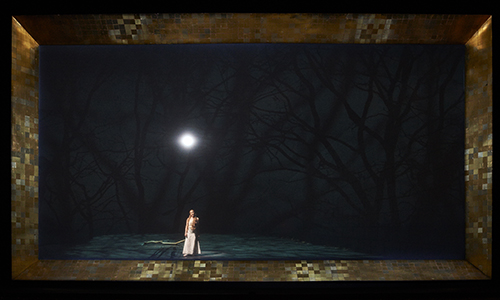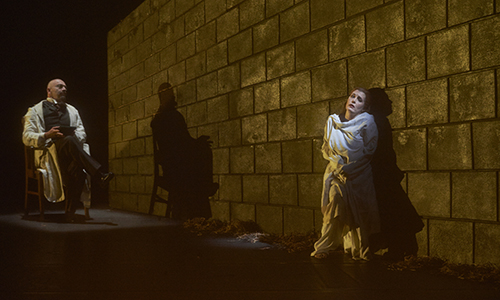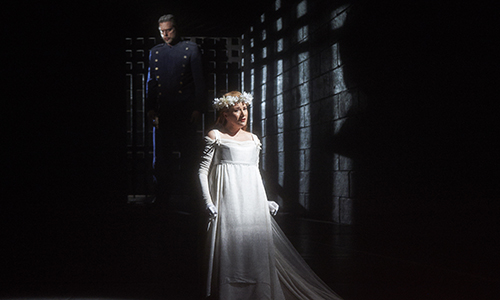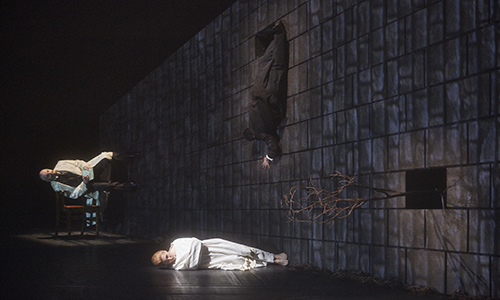-
10 Things to Know: Bluebeard's Castle/Erwartung
By Kiersten HayPosted in Bluebeard/Erwartung
Robert Lepage's iconic double-bill Bluebeard's Castle/Erwartung returns to Toronto to be performed for the first time on the Four Seasons Centre stage. Read on to discover the top 10 reasons why you have to get tickets for this spine-chilling duo of opera masterpieces while they last!
1. PUTTING THE COC ON THE MAP
Québec City native Robert Lepage is indisputably one of the most original theatre artists Canada has ever produced. His ground-breaking 1993 production of Bluebeard’s Castle/Erwartung was a watershed moment for the COC, establishing it as one of the world’s most visionary and compelling opera companies. Following its Toronto premiere, it garnered world-wide acclaim touring to New York, Edinburgh, Melbourne and Hong Kong. This spring Toronto audiences will be hearing the stunning sonic effects of these two revolutionary scores for the first time in the acoustic splendour of the Four Seasons Centre for the Performing Arts.
2. DESIGNED BY THE TIMES
Set and costume designer Michael Levine draws inspiration for his visuals from the social and artistic zeitgeist of the period of composition. He cites Austrian painter Gustav Klimt’s richly gilded canvases as a reference for the huge gold frame that surrounds the proscenium and points to the sombre, unnerving works of Klimt’s Norwegian contemporary, Edvard Munch, as inspiration for his stage design.

3. “IT WAS A REAL CELEBRATION OF THE NEUROTIC, A CELEBRATION OF THE ‘ANTI’”
Robert Lepage describes Erwartung as very “dark; a work of despair; Schoenberg doesn’t give any keys or clues to this piece. It’s very erratic—a sort of Freudian voyage.” He highlights these Freudian aspects by setting the opera in a mental ward where the sole character, “The Woman,” is straightjacketed and flooded by memories as she recounts the events of her search for her lover.

4. BEYOND TONALITY
Largely self-taught, Viennese composer Arnold Schoenberg’s (1874–1951) innovative experiments with harmony moved art music away from the late-Romantic lushness of Richard Strauss and Gustav Mahler towards an atonal sound world that threw over the conventional rules of Western harmony. With his early opera Erwartung (1909), he extended the boundaries of tonality so far as to become the first composer to overstep them. You can hear guided samples at coc.ca/LookAndListen.
5. WHEN THE OLD BECOMES NEW
Unlike Schoenberg, Hungarian Béla Bartók (1881-1945) did not reject contemporaries such as Richard Strauss and Claude Debussy—in fact, early works such as Bluebeard’s Castle (1911) were strongly influenced by their style. Instead, it was his research into the old, forgotten folk melodies of Hungary that freed him to create a unique musical fabric dominated by surprising, new dissonances.
6. “IT WAS THE END OF A LOT OF EMPIRES…”
In 1903, spurred on by the new anti-Austrian, anti-Habsburg movement in Hungary, Bartók declared in a letter: “all my life, in every way I shall serve but one aim; the benefit of the Hungarian nation.” He completed Bluebeard’s Castle in 1911, just six years before the collapse of the Austro-Hungarian Empire. As the production’s creator, superstar Canadian director Robert Lepage, points out, “It was the end of a lot of empires; the end of a lot of Bluebeards who possessed lands and jewelry, but whose money was stained with blood.”

7. UNLEASHING THE SUBCONSCIOUS…
Schoenberg’s Erwartung is very much a product of the Expressionist movement that swept through all the arts during the early 20th century. His break from the traditional Western harmonic tradition with atonality unleashed a similarly “expressionist” sound world equipped to expose heated emotions of frightening power that had theretofore remained under wraps. Schoenberg’s librettist, the young medical student Marie Pappenheim, based her text on the elliptical, resonant language of patients undergoing psychoanalysis. As a member of the medical community, Marie may well have been familiar with “Anna O,” one of Sigmund Freud’s most famous patients—certainly there are similarities between that case and the text of Erwartung.
8. “THE SEISMOGRAPHIC RECORDING OF TRAUMATIC SHOCKS”
Erwartung’s complex score is particularly challenging due to its “in-between” status—Schoenberg wrote it after he had abandoned tonality (c. 1909) but before he had devised the 12-tone system (early 1920s). German philosopher and musicologist Theodor Adorno famously described it as being akin to “the seismographic recording of traumatic shocks;” a fragmentary score that almost never settles on any type of repeated theme or motif that might potentially offer definitive answers.

9. “WE CAN ONLY KNOW FOLK MELODIES THROUGH DIRECT CONTACT WITH PEASANTS”
Previous to Bartók’s re-discovery of his homeland’s rich treasury of authentic melodies, the Hungarian classical “nationalist” style had been dominated by folk-like popular songs which were in fact corruptions of truly indigenous music. However, Bartók did not simply incorporate these folk materials verbatim; any of his “melodies” are entirely his own. Instead, he used them as models to intensify rhythms, expand his tonal palette and ultimately, explore the new dissonances that came to define his music. You can hear guided samples at coc.ca/LookAndListen.
10. THE PLAYERS
Canadian star, bass John Relyea, relishes the psychological challenges posed by Bluebeard who spends the entire opera in continual dialogue with his latest wife, Judith: “the through line of emotional tension is unbroken, relentless; likewise the score builds up dramatically as things get deeper and darker and doesn’t let you go.”
Relyea’s Judith will be Russian mezzo-soprano Ekaterina Gubanova with whom he has worked at Covent Garden. Relyea feels this will be “especially important in a piece that is very intimate; very exposed psychologically—having established trust with a colleague beforehand is extremely helpful in creating something very real earlier in the process of developing the characters.”
Canadian mezzo-soprano Krisztina Szabó’s (The Woman, Erwartung) association with this production goes back to her days in the COC Ensemble Studio when she understudied the role of Judith in Bluebeard’s Castle. She calls her new role “probably the most challenging thing I’ve worked on to date. After looking at the first three pages I thought, ‘It’s never going to stick in my head,’ but it’s extremely satisfying when the puzzle falls into place!”
To find out more about our production of Bluebeard's Castle/Erwartung, click here.
Photo credits (top-bottom): (l-r) John Relyea as Duke Bluebeard and Ekaterina Gubanova as Judith in the Canadian Opera Company production of Bluebeard’s Castle, 2015, and Krisztina Szabó as the Woman and Mark Johnson as the Psychiatrist (in background) in the Canadian Opera Company production of Erwartung, 2015. Photo: Michael Cooper; Krisztina Szabó as the Woman in the Canadian Opera Company production of Erwartung, 2015. Photo: Michael Cooper; (l-r) Mark Johnson as the Psychiatrist and Krisztina Szabó as the Woman in the Canadian Opera Company production of Erwartung, 2015. Photo: Michael Cooper; John Relyea as Duke Bluebeard and Ekaterina Gubanova as Judith in the Canadian Opera Company production of Bluebeard’s Castle, 2015. Photo: Michael Cooper; (l-r) Mark Johnson as the Psychiatrist, Krisztina Szabó as the Woman and Noam Markus as the Lover in the Canadian Opera Company production of Erwartung, 2015. Photo: Michael Cooper
